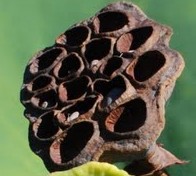
The sacred lotus, also known as Indian lotus, is an aquatic perennial native to tropical Asia and Australia. It is one of two extant species in the Nelumbonaceae family and has as been cultivated in China for over 3000 years for its ornamental, medicinal and culinary value. With symbolic meaning in both Hinduism and Buddhism it is the national flower of India and Vietnam. The cup-shaped pink or white flowers are eight to twelve inches across and are produced on erect stems above the foliage. They open during the day and close at night over a period of about three days. In the center of each flower is an inverse-cone receptacle that is two the three inches across and bears the nut-like seeds that are very long lived, up to 1300 years. The receptacle, which differentiates lotus from water lily, becomes woody and is valued for dried arrangements. The green waxy leaves of the sacred lotus are up to two feet across and are held above the surface of the water on stems (petioles) up to 6 feet long that are attached to the center of the leaf-back. The plant is anchored in the mud by a rhizome that spread and form colonies. Sacred lotus is suitable for the margin of a pond or other body of water. It is often planted in containers so the plants can easily be moved for aesthetic or practical reasons. The genus name, Nelumbo, is the Sinhalese name for the plant. The specific epithet, nucifera, comes from the Latin word nux, meaning nut, and ferre meaning to bear and refers to the fruit of the plant.

Type: Aquatic perennial
Bloom: Cup-shaped, pink or white flowers, 8-12” across in summer
Size: 3-6’ H x 3-4’ W
Light: Full sun
Soil: Organically rich, calm water

Hardiness: Zones 4-10
Care: Low maintenance
Pests and Diseases: None of significance; susceptible to aphids and red spider mites.
Propagation: Seed
Companion plants: Water lilies, cannas, pickerel weed, pond lily, water poppy
